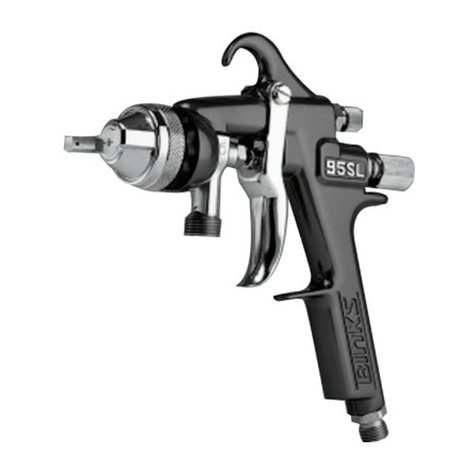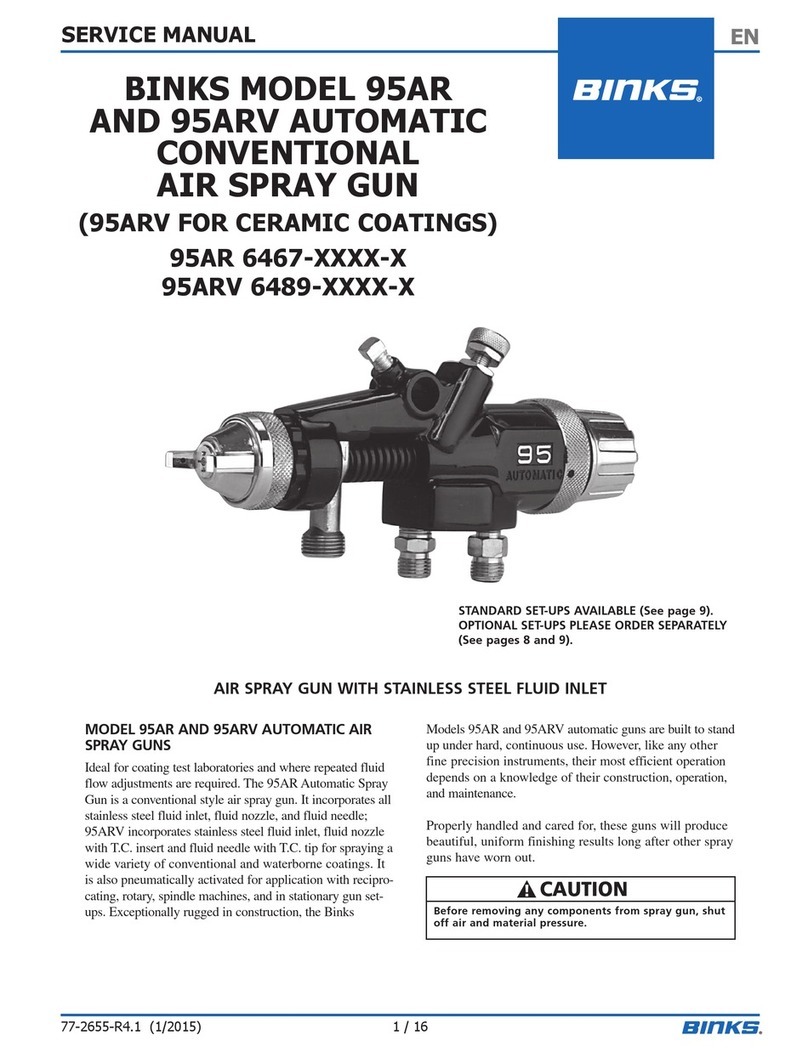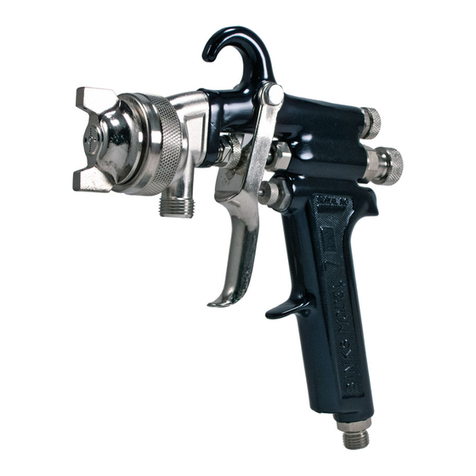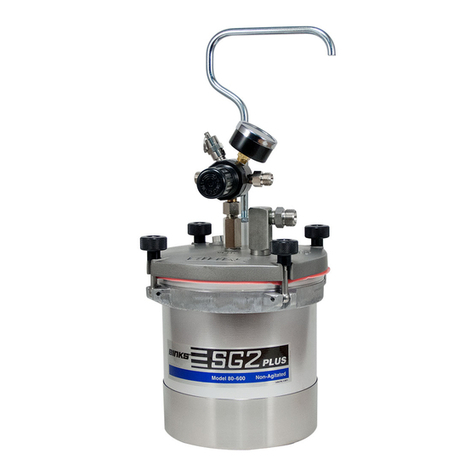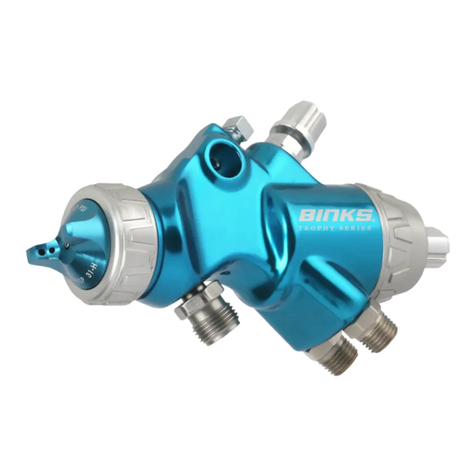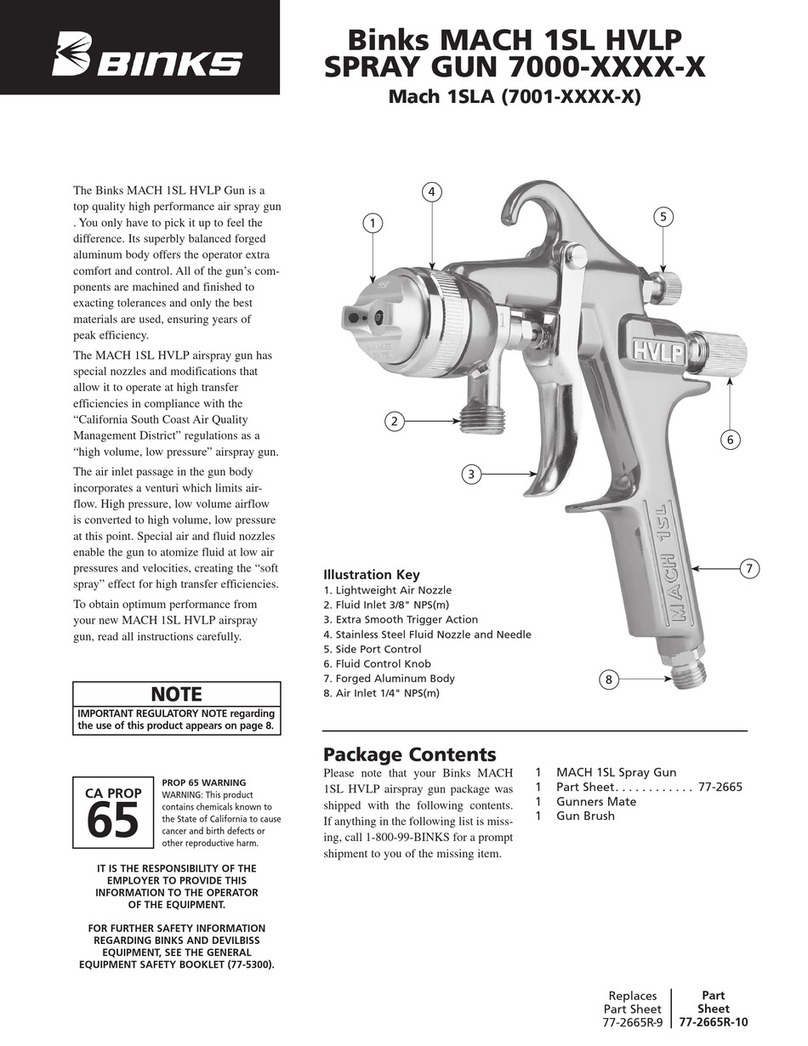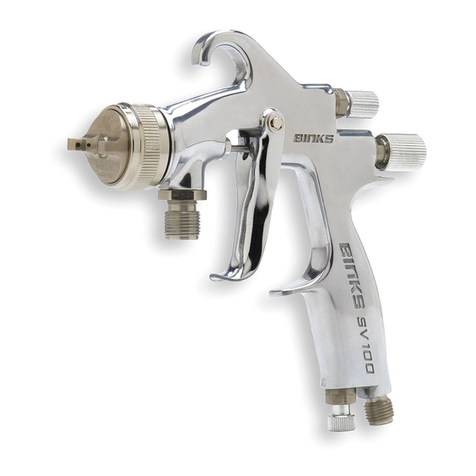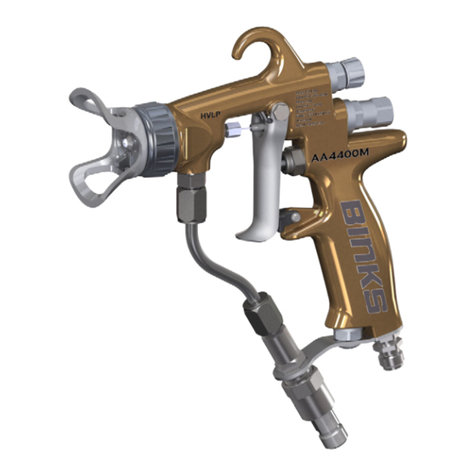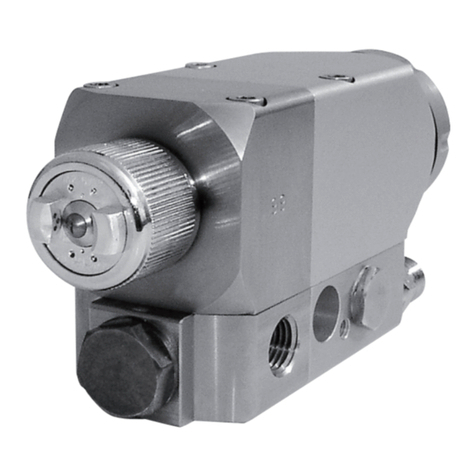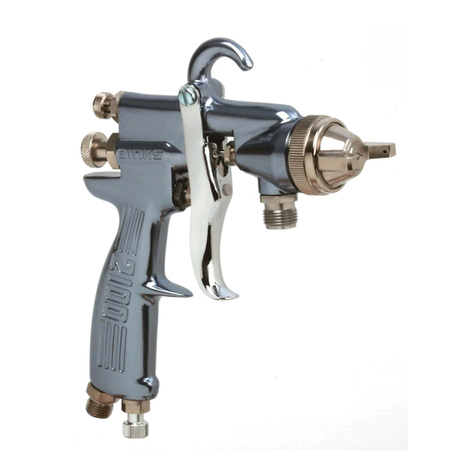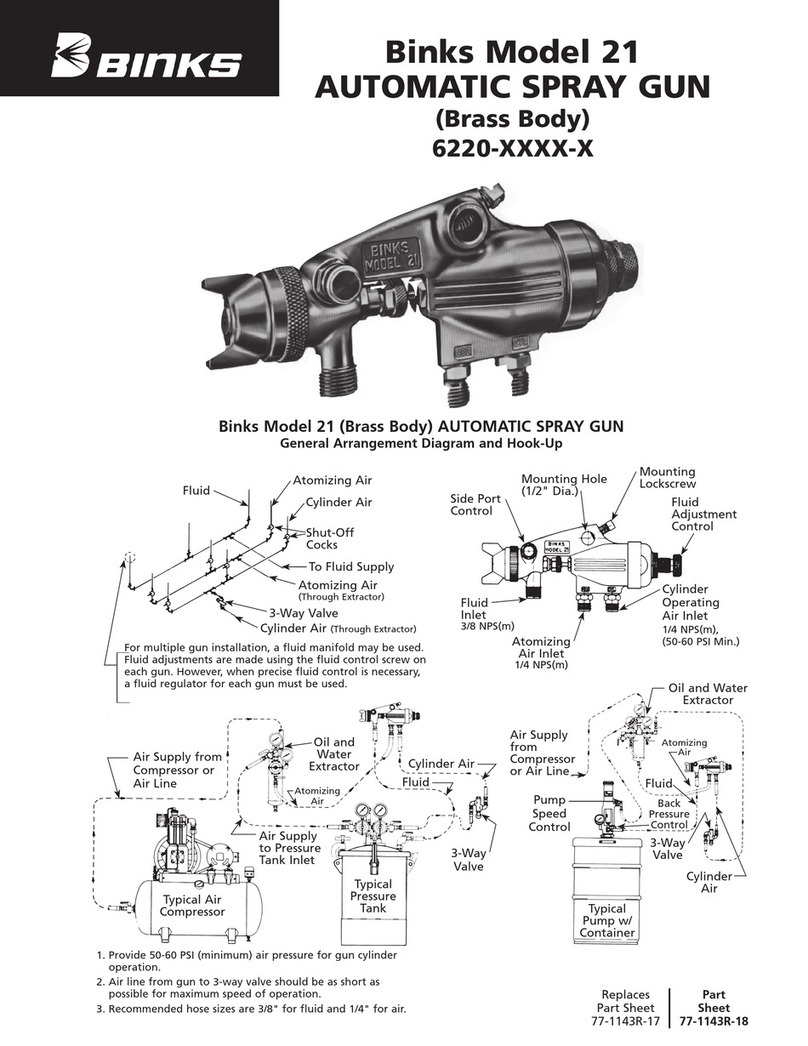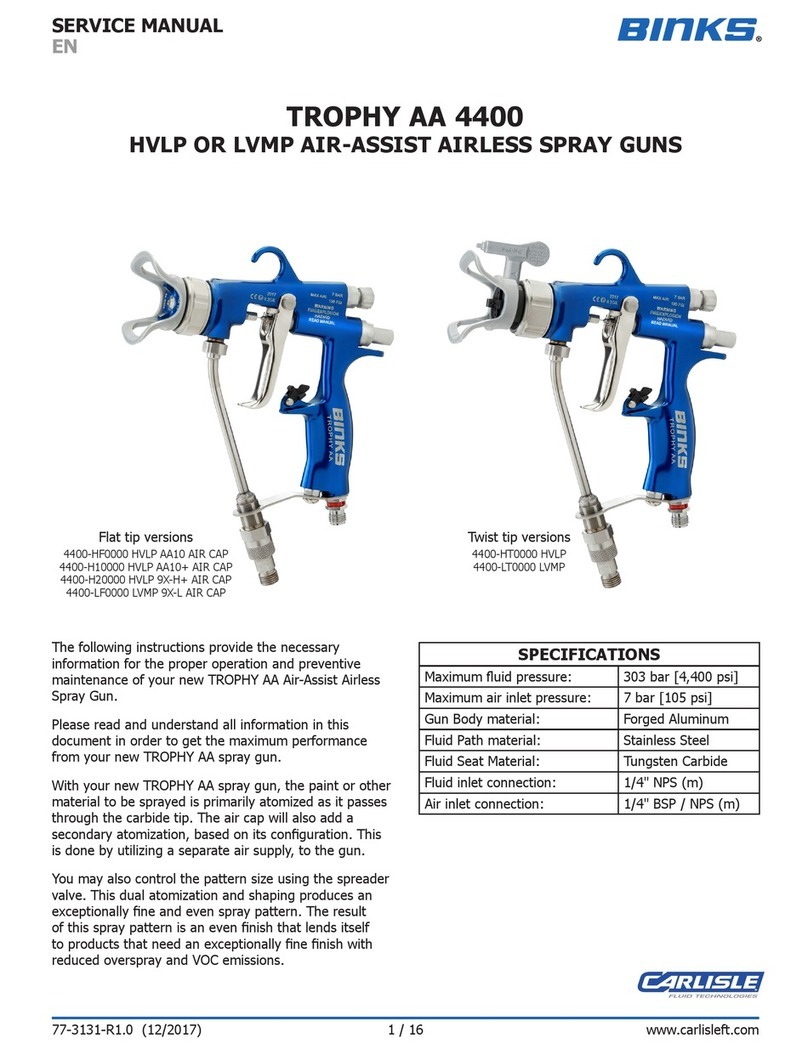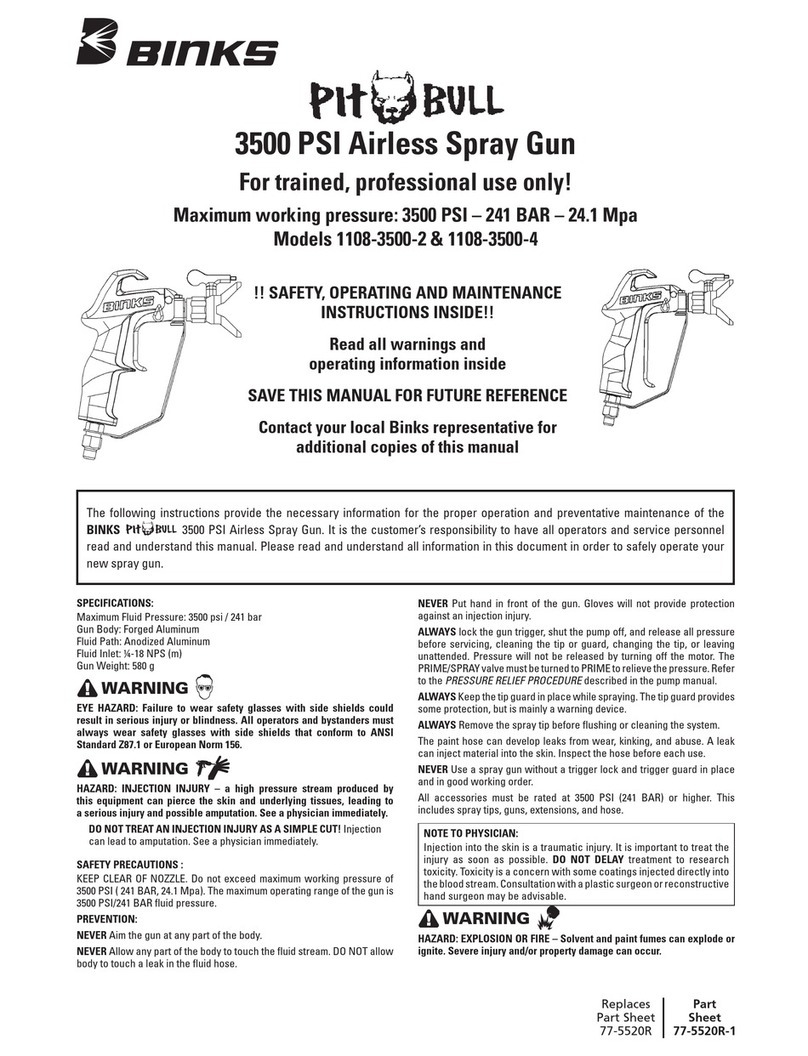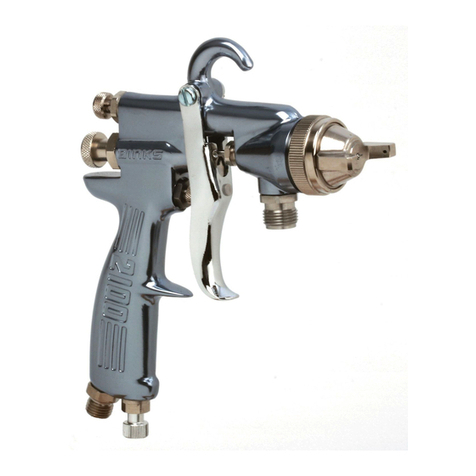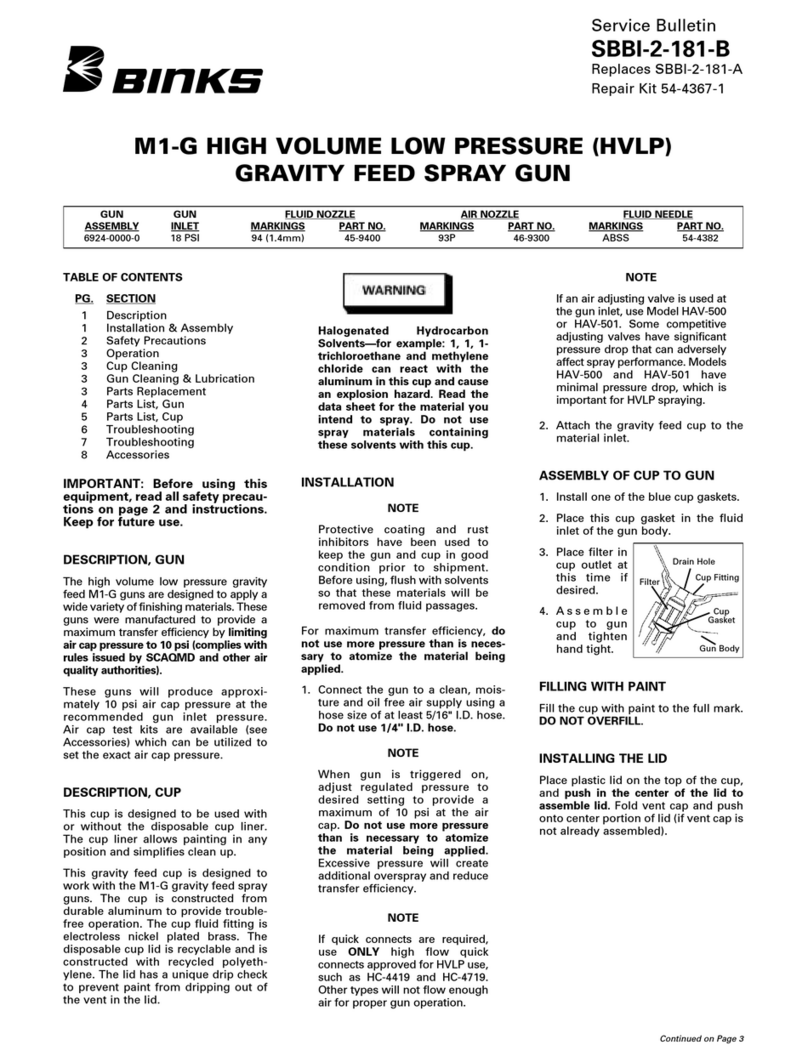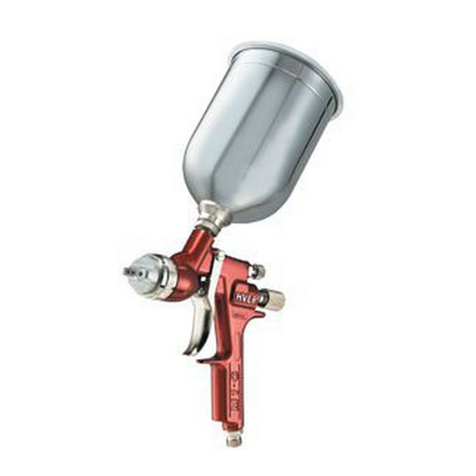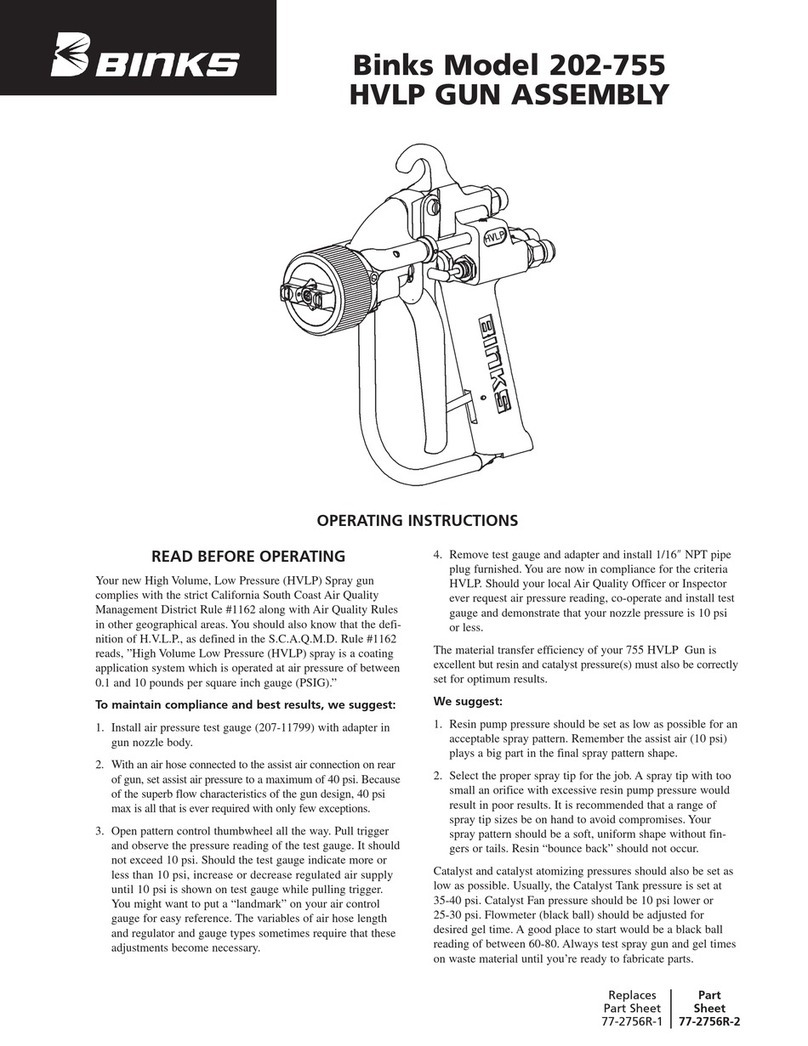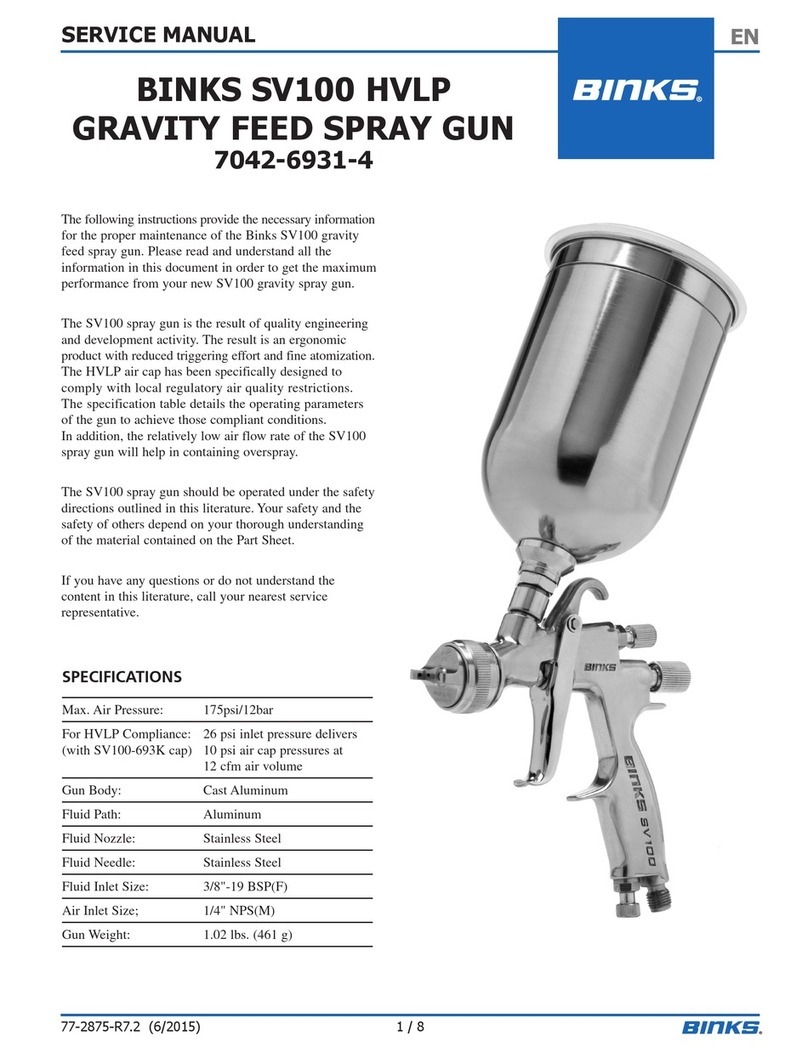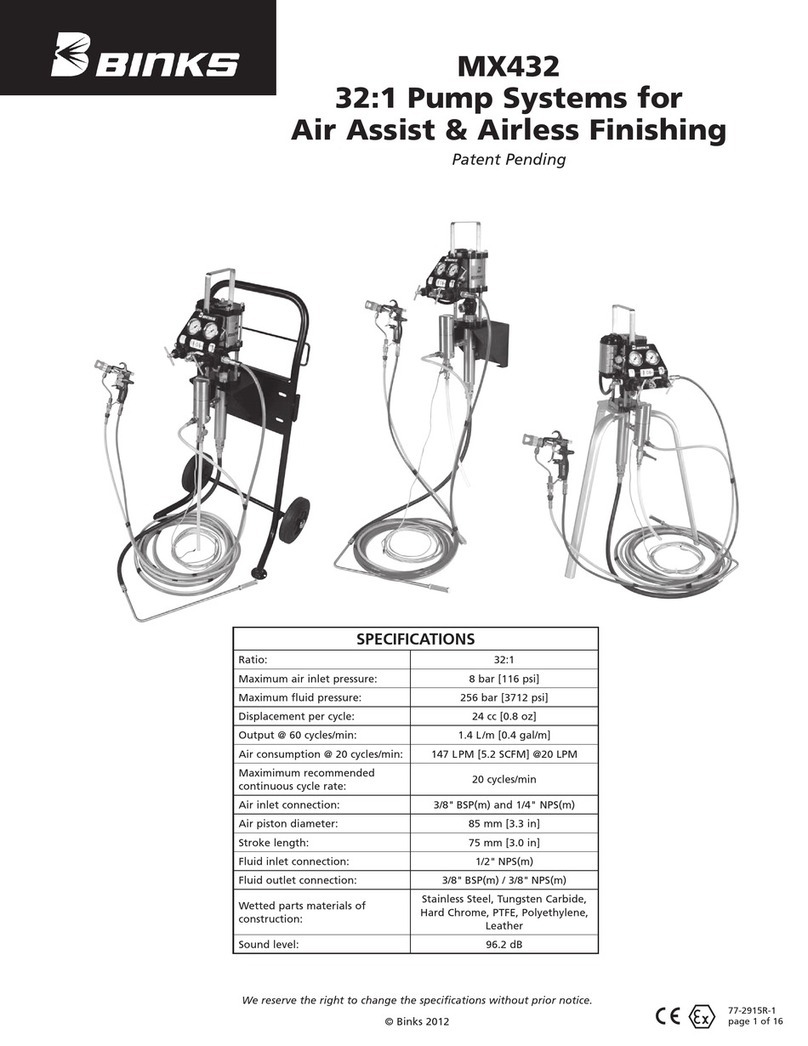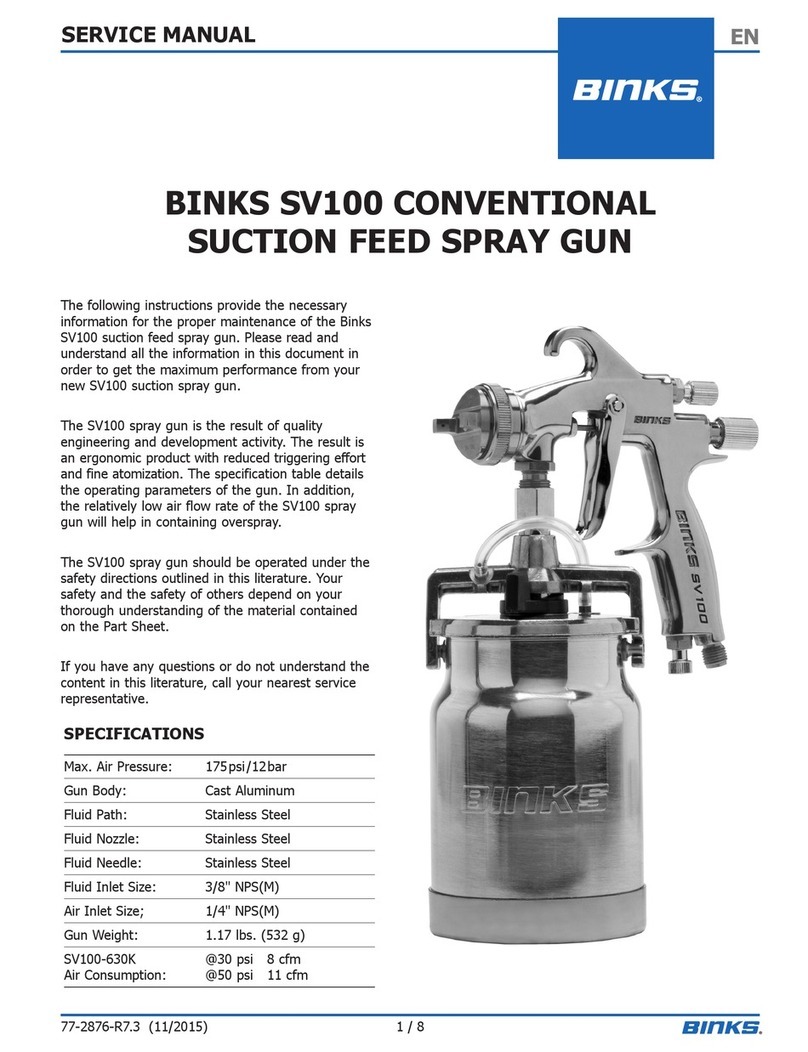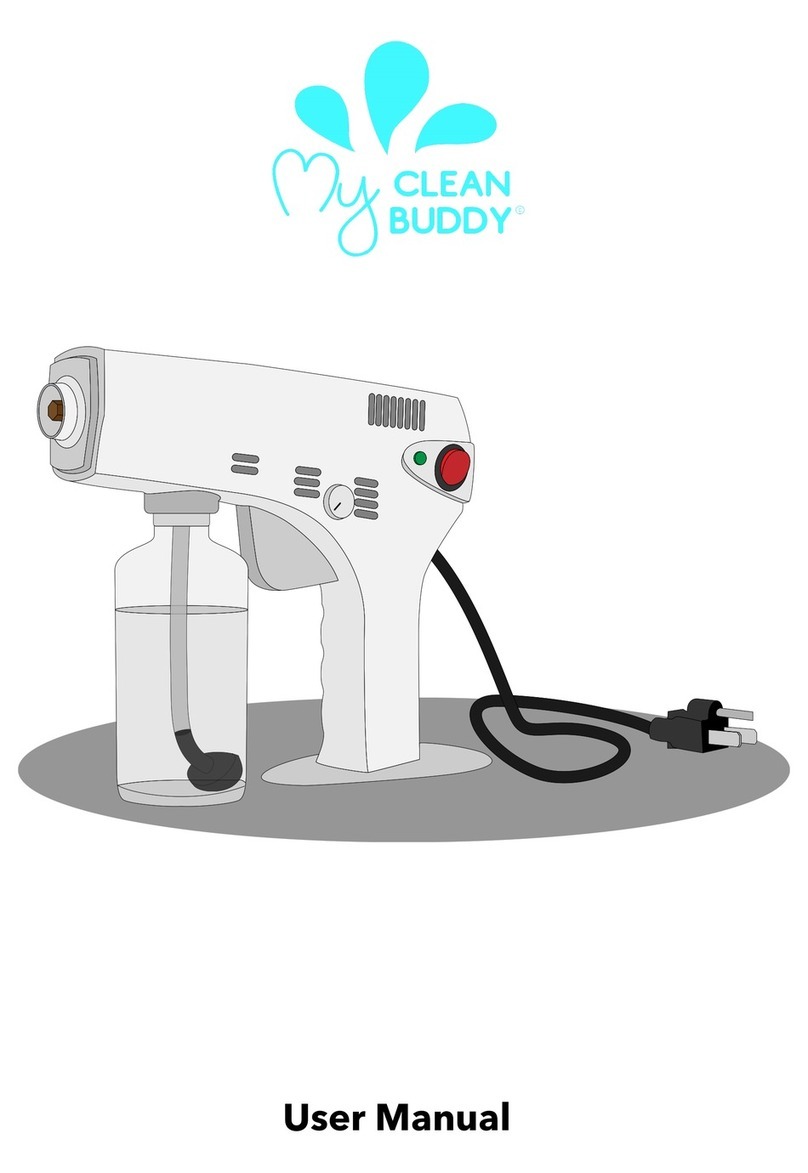5
CLEANING INSTRUCTIONS
Disassemble and thoroughly clean filter
assembly (40) each time spray gun is
cleaned. Before reassembly, spray gun
should be blown dry and inspected to
make sure debris is not lodged in any of
the air and fluid passages. After reassem-
bly of filter assembly, lightly lubricate
piston assembly (26) to insure smooth
trigger action.
In certain states it is illegal to spray
solvents containing Volatile Organic
Compounds (VOC’s) into the atmos-
phere when cleaning a spray gun. Binks
recommends that you comply with these
air quality laws by following one of the
two methods described below.
1. Use an enclosed clean-up station or
enclosure which will condense and
collect VOC vapors to prevent their
atmospheric release.
2. Use a washer unit.Your gun washer
should completely enclose the spray
gun, filter, nozzles and other parts
during wash, rinse and drain cycles to
prevent the release of VOC vapors
into the atmosphere.
Lubricate all o-rings and moving parts at
reassembly into the gun body.
To further protect the environment,
avoid storing solvents or solvent-soaked
wipes, such as those used for surface
preparation and cleanup, in open or
absorbent containers.
TROUBLESHOOTING
Numbers in parentheses refer to individ-
ual items shown in the “exploded” draw-
ing on page 6.
Uneven spray patterns are usually caused
by a clogged spray tip assembly (3). To
clear the tip, shut off the cylinder air and
remove retainer ring (1), air cap (2) and
tip. Rinse tip in solvents and clean the
orifice with compressed air, then
reassemble.
Intermittent or fluttering spray can be
caused by a clogged filter assembly (40)
or erratic fluid supply. To service the fil-
ter assembly, relieve all fluid pressure
throughout the system, then disassemble
and clean the filter assembly thoroughly.
Always inspect the filter element (42)
when cleaning the filter assembly and
replace damaged elements before
reassembly.
If fluid leaks from the spray tip assembly
when the cylinder air is shut off, remove
and inspect both the carbide seat (6) and
the ball end of the material valve assem-
bly (30). Replace any worn or damaged
parts. Be sure to follow the safety pre-
cautions outlined on page 2.
If fluid leaks past the fluid cartridge
assembly (32), replace the assembly. Be
sure to follow the safety precautions
outlined on page 2.
MAINTENANCE INSTRUCTIONS
Numbers in parentheses refer to individ-
ual items shown in the “exploded” draw-
ing on page 6.
FLUID CARTRIDGE
REPLACEMENT
To remove the fluid cartridge assembly
(32), first remove the material needle
control knob (39), end cap (38) and
springs (36, 37). Loosen wire chuck (35)
from needle body (34). Remove the
retaining ring (1), air cap (2), spray tip
assembly (3), seat retainer (4), carbide
seat (6), and seal assembly (7). Unscrew the
fluid nozzle body (11) with a 1/4" allen
wrench. Loosen fluid cartridge assembly
(32) and pull out the wire and ball
assembly (31) from the front of the gun.
Remove and replace cartridge assembly
(32) and reassemble in reverse order.
PISTON REMOVAL
To remove the piston assembly (26),
unscrew the end cap (38), remove the
two springs (36, 37) and pull out the
entire material valve assembly (30).
Remove the piston assembly by applying
compressed air (about 5 PSI) to the
cylinder air inlet. The air pressure will
cause the piston assembly to pop out.
LUBRICATION
Lubricate the gun by removing the pis-
ton (28) and lubricating the needle return
spring (36) and the bore in which the
piston travels with petroleum jelly.
Periodically lubricate the side port con-
trol assembly (15) with oil.
SPRAY GUN CLEANING & MAINTENANCE INSTRUCTIONS
CAUTION
Never use metal instruments to clean
or scrape fluid or air nozzles. These
parts have been carefully machined
and altering their shape will cause
faulty spray.
!
CAUTION
Never use metal instruments to clean
or scrape fluid or air nozzles. These
parts have been carefully machined
and altering their shape will cause
faulty spray.
!
CAUTION
Never use lubricants containing sili-
cone since these lubricants can cause
finish defects. Binks Gunners Mate
(54-3871) is recommended.
!
WARNING
Be sure to follow all safety precau-
tions described on page 2 before
working on the spray gun. Never
work on the spray gun until fluid
pressure has been relieved through-
out the system and the power or air
supply for the fluid pump has been
disconnected. Always test the
repaired gun for leaks with low
pressure fluid before use.
!
WARNING
Aim the gun rear in a safe direction
and use only low pressure air when
removing the piston assembly.
Removing the piston while under
pressure could result in damage to
components or personal injury.
!
NOTE
Disassemble spray gun and remove
all o-rings (21), (25), (29), (33) & (48)
before immersing gun in or subject-
ing it to a flood-wash of cleaning
solvent. Contact with solvents may
induce o-ring swelling beyond their
specification sizes and cause subse-
quent malfunction of the gun.
